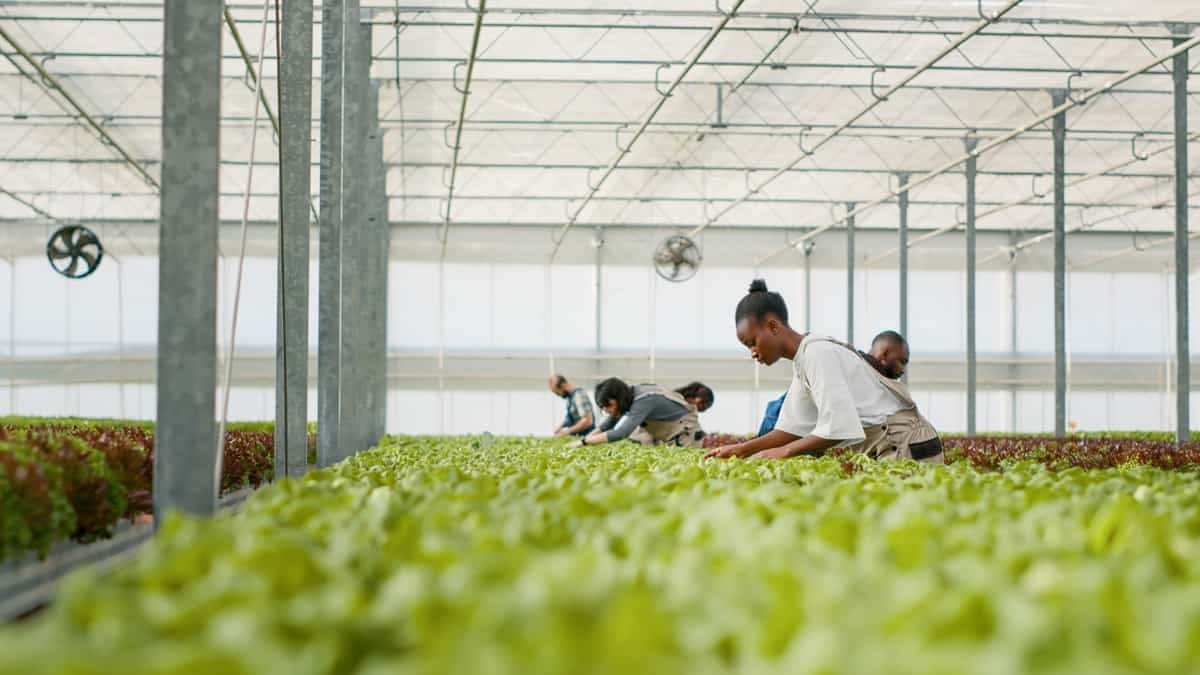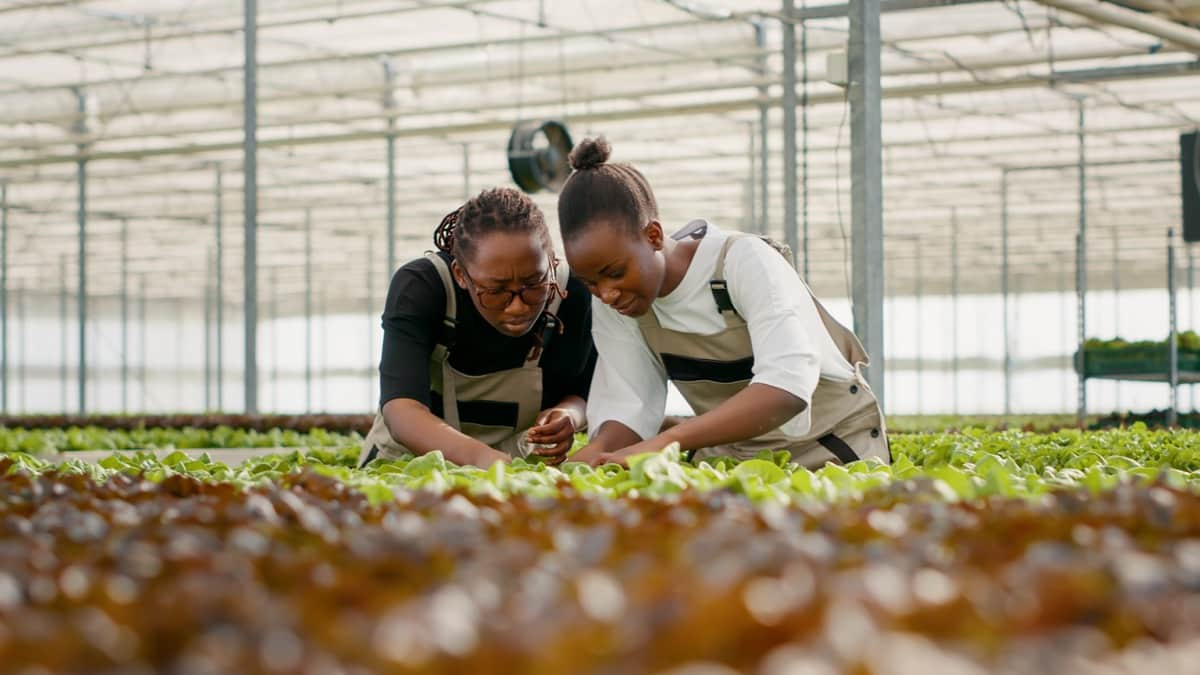North and West Yorkshire is one of the UK’s leading centers for CEA (controlled environment agriculture), with an unrivaled cluster of producers, partners, suppliers, and customers. North and West Yorkshire companies are at the heart of the next agricultural sector revolution, using CEA techniques to produce food.

As CEA becomes more widespread, North and West Yorkshire will likely become a major center for this type of agriculture in the UK. This would boost the regional economy and create new jobs in an industry poised for growth.
Controlled agriculture in North and West Yorkshire
What is meant by controlled environment agriculture?
CEA is a modern and intensive form of hydroponic-based agriculture where plants are grown in a controlled environment to improve horticultural practices. CEA is where parameters, such as light, temperature, relative humidity, and sometimes the partial gas pressure (and possibly its composition), are fully controlled. This includes smart technologies for monitoring glasshouses to vertical farming, where fresh produce is grown in stacked layers under LED lighting.
CEA systems can grow various crops, including fruits, vegetables, herbs, and flowers. They can be used in both small-scale and large-scale operations. In some cases, CEA systems supplement traditional outdoor farming operations, while in other cases, they replace traditional farming entirely.
Location for controlled environment agriculture
North and West Yorkshire is an excellent location for the CEA because of its wide variety of plants and insects. Modern local farming techniques and the circular economy only fuel the opportunity. The region has a growing agri-tech industry, encouraging Europe’s largest projects, start-ups, and technology companies. Investors here can cooperate with more than 13,000 farms, 700 food production companies, and 25,000 workers.
The climate in North and West Yorkshire is ideal for controlled environment agriculture. The region experiences moderate temperatures and ample rainfall, which are necessary for successful crop production. Also, the region’s proximity to the coast means a constant supply of fresh air, another important element for successful CEA.
Plenty of resources are available for this agriculture in North and West Yorkshire. The region is home to several universities and research institutes working on developing new technologies for controlled environment agriculture. Additionally, many regional horticultural businesses can provide advice and support for setting up a CEA operation.
Finally, the infrastructure in North and West Yorkshire is well-suited to supporting CEA operations. The region has an extensive network of roads and railways, making it easy to transport goods and materials to and from CEA facilities. A strong telecommunications infrastructure is also essential for connecting CEA operations with the outside world.
What are the major benefits of controlled environment agriculture?
CEA can allow farms to dial in optimum growing conditions to operate productively year-round, regardless of weather or seasons. Controlled Environment Agriculture aims to create the optimum growing conditions, allowing year-round cropping of a wide range of high-value, fresh produce closer to the point of consumption. Such techniques include vertical farming, aquaponics, aeroponics, and hydroponics. Other opportunities also lie in insect rearing for protein usage, potentially reducing the environmental impact of other proteins in animal feed and the bio-economy.
The most significant benefit is the ability to produce food crops year-round, regardless of the weather outside. This means that farmers can avoid the risk of crop failure due to unfavorable weather conditions. Additionally, CEA systems can be located anywhere in the world, making them ideal for regions with limited farmland or harsh climates.
In case you missed it: Can You Grow Sweet Potatoes from Store-bought Sweet Potatoes: A Step-by-step Process Guide

- In addition, CEA can be used to control pests and diseases without the use of harmful chemicals. This is better for the environment and also results in higher-quality crops. CEA systems can also be automated to a certain extent, which reduces labor costs.
- CEA systems can also be designed to minimize water and fertilizer use. This is important not only for conservation purposes but also for reducing operating costs. In some cases, CEA systems even allow the recycling of water and nutrients back into the system, further reducing inputs.
- It provides an opportunity for farmers to connect directly with consumers. By selling produce through community-supported agriculture programs or farmer’s markets, farmers can build relationships with customers and get feedback about their products.
Growth Prospects of CEA in North and West Yorkshire
Market demand for this agriculture is strong due to high population density, high GDP per capita, and a significant segment of consumers who will pay for added-value fresh food. However, the UK is only 61% self-sufficient in food, and this gap could be closed through the CEA.
Vertical farming is an exciting and fast-growing sector with a CAGR of 25% over the next five years. As a result, the global market opportunity is predicted to grow from £1.5 billion to £8 billion in 2030. Many factors drive growth and has many benefits, including great sustainability.
The future of CEA in North and West Yorkshire
CEA systems provide a high level of control over the growing environment. This allows farmers to tailor conditions precisely to their crops’ specific needs. Especially in automated environments, CEA can allow farmers to maximize their time by focusing on the plants and not manually adjusting environmental variables. The future of CEA in North and West Yorkshire looks bright.
CEA farms will become even more efficient and productive with continued innovation and investment. They will also have an increasingly positive impact on the environment. CEA will play an increasingly important role in meeting our food needs. In addition, as we face challenges such as climate change and water shortages, CEA could be a key part of developing sustainable agricultural practices that can help feed the world in a more environmentally friendly way.
What are the types of controlled environment agriculture?
CEA technologies include hydroponics, aeroponics, aquaculture, and aquaponics. Different techniques are available for growing food in controlled-environment agriculture (CEA). CEA uses technology to enable growers to manipulate a crop’s environment to desired conditions. Greenhouses, hydroponics, and aquaculture are all examples of CEA.
In case you missed it: Arecanut Profit Per Acre: Cost of Cultivation, Planting Distance, Intercrops, and Yield

- Hydroponic systems grow plants in a water-based solution without the use of soil.
- Aeroponic systems grow plants in an air-based environment without using soil.
- Aquaponic systems combine hydroponics and aquaculture with growing plants and fish in one closed system.
Each type of controlled environment agriculture has its benefits and drawbacks, but all can produce fresh, healthy food year-round without using traditional farming methods.
Conclusion
CEA in North and West Yorkshire is an exciting opportunity for farmers and consumers. By utilizing advanced technology to create a controlled environment, farmers can produce high-quality crops with minimal inputs of resources such as water and energy while still meeting their customers’ demands. CEA is an approach to food production that uses controlled environmental conditions to optimize plant growth. This includes temperature, humidity, light, and carbon dioxide levels.
- Feed Your Flock for Less: Top 10 Tips to Save on Chicken Feed
- Ultimate Guide to Ossabaw Island Hog: Breeding, Raising, Diet, and Care
- Hatching Answers: The Top 10 Reasons Your Chickens Aren’t Laying Eggs
- Eggs and Economics: Breaking Down the Cost of Raising Backyard Chickens
- Defend Your Greens: Proven Methods to Keep Iguanas Out of Your Garden
- Ultimate Guide to Cinnamon Queen Chicken: A Comprehensive Guide for Beginners
- Ultimate Guide to California Tan Chicken: Breeding, Raising, Diet, Egg-Production and Care
- Ultimate Guide to Marsh Daisy Chicken: Breeding, Raising, Diet, and Care
- 10 Types of Chicken Farming Businesses You Can Start for Profits